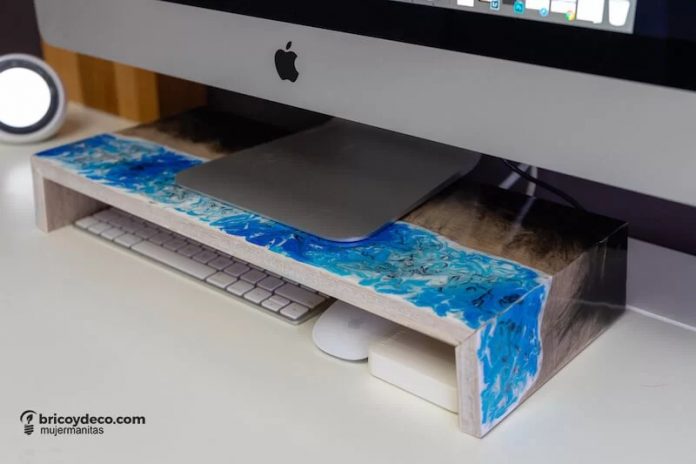
The 3D epoxy resin or liquid porcelain tile provides a crystalline layer of great hardness on different materials. However, it can also be colored with pigments to give it a decorative finish. With this guide you will learn techniques, tips and tricks on how to use pigments for epoxy resin and get the best result.
In my previous article on everything you should know about 3D epoxy resin or liquid porcelain tile, I explained how to prepare and apply this type of epoxy resin, as well as the most frequent problems you may encounter. To complement it, I wanted to prepare this guide with everything you should know about pigments for epoxy resins. Thanks to it you will learn to color epoxy resin and create effects such as marbling, smoked or a waterfall.
You can also see a practical application in this video tutorial on how to make a monitor shelf:
What type of pigment is the most suitable?
One of the most frequently asked questions when it comes to giving color to our projects with epoxy resin is if you can use pigments for oil paints, aniline dyes, chalk powder or even eye shadow. To answer this question, the following must be taken into account:
- Epoxy resin requires a catalyst to harden.
- The union of both components involves a series of chemical reactions.
- A special pigment for epoxy resin guarantees that the curing process will not be altered.
- The pigment for epoxy resin provides a solid and uniform color.
In short, the use of pigments that are not special for epoxy resins can lead to undesirable results that spoil your project with epoxy resin.

How much pigment do I need?
The amount will depend on the color of the pigment and the type of finish (opaque or translucent). In general, the pigments for epoxy resins are very concentrated and a small amount is needed to color it. For this reason, my advice is to start very small and add until you achieve the desired opacity.
A trick to find out if the color obtained is more or less opaque is to apply a few drops of pigment and stir with a rod. If you can see the material on the stick when you remove it, the mixture is translucent. Otherwise, an opaque color will have been obtained that will not reveal the background or support on which it is applied.

How is the pigment applied to the epoxy resin?
For get a uniform color the following steps must be followed:
- Weigh out a quantity of epoxy resin
- Add a few drops of pigment
- Stir with a rod until the mixture is homogeneous
- Add the proportion of catalyst (2:1 in the case of Epoxy Resin 3D Transparent Floors or liquid porcelain from Nazza)
- Stir the mixture again with the rod
If you want to achieve a marbled or smoky effect, you can combine the resin and catalyst and then add drops of pigment to create more artistic patterns.

What effects can be achieved with pigments?
In addition to a translucent or opaque color finish, with pigments for epoxy resin you will be able to make high visual impact effects such as the following:
- Marbled effect. To do this, a base pigment is applied and drops of one or two contrasting color pigments are added. In this way you will obtain very showy and unrepeatable patterns.
- smoked finish It consists of applying a first layer of solid color and waiting 24 hours to apply a second layer of transparent epoxy resin. A few drops of pigment will be added to the edge only, blending it out for a translucent finish.
- Degraded. It is obtained by combining the same color of epoxy resin with different degrees of opacity.
- three-dimensional color It is achieved by applying thin layers of transparent epoxy resin with superimposed touches of color. That is, a transparent layer is applied and a drop of pigment is blurred. Wait 24 hours and apply a second transparent layer, blurring a drop of pigment of a different color on the areas where the lower layer is transparent. The same operation is repeated for each color that you want to obtain.
Different colors can also be mixed to obtain new ones, although the result is unpredictable and is not as homogeneous as that achieved with a pure color pigment.

did you know the pigments for epoxy resin? I hope this guide has cleared up your doubts about how to use them and will help you make your work with 3D epoxy resin or liquid porcelain much more creative.
If you liked this post, visit , you will find many more practical guides and DIY projects.



